1•
Structure of the Fashion Market
Fashion is a global market with a complex structure that operates on many different levels to reach everyone from fashionistas to those who just purchase clothing as a necessity of everyday life. The range and scope of fashion is immense; from an ornate haute couture gown made by hand in a Paris atelier to a simple mass-produced T-shirt manufactured in China, this opening chapter will provide you with an outline of the basic structure of the fashion industry and explain these different levels of the market. The chapter also features information on the industry’s most influential fashion centres.
Fashion market sectors
The fashion market is broken down into specific sectors so that companies are better able to analyse market data and monitor their business results more effectively. Market statistics can be compiled and analysed by one or more of the following criteria:
•Market or product category
Apparel, accessories, perfume or homeware. The apparel market can be further subdivided into womenswear, menswear and childrenswear
•Product type, end-use of product or fashion style
Denim, lingerie, sportswear, formal wear or contemporary fashion
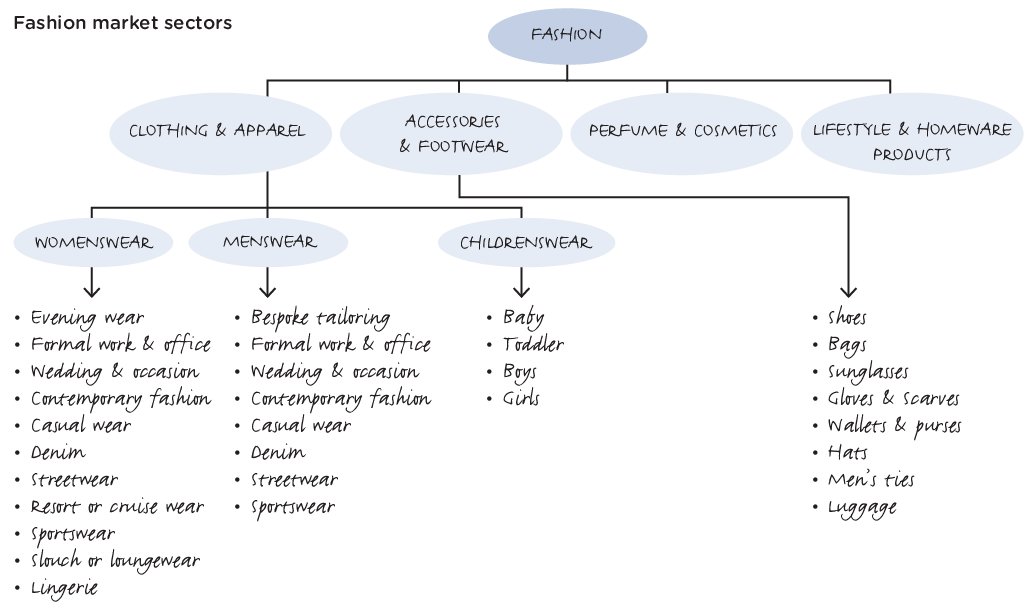
The diagram gives an indication of some of the key market and product sectors within womenswear, menswear, childrenswear and accessories. As new niche markets develop, so the chart can be adapted to include emerging sectors, for example, clubwear, urban wear, and surfwear.
Couture, luxury, mid-market or value market
•Location of market
Global, international, national or regional
Market information
Fashion analysts publish market reports and data analysis on most of the key international fashion market sectors. This information is helpful in assessing the relative size of specific markets or estimating future market potential.
Womens-, mens- and childrenswear Data from Verdict Retail, part of the Datamonitor Group, indicates that in 2009 consumers spent £19.1 billion on womenswear with spending on menswear and childrenswear at £9.0 billion and £4.6 billion respectively. The market in the US is considerably larger; for 2009 the womenswear market was US$104 billion, menswear US$51 billion and childrenswear US$33.5 billion. The childrenswear market is typically defined as clothing for children under the age of 14. The main sectors are infants’ clothing (babies and toddlers under two years old), girls’ clothing (ages 2–14) and boys’ clothing (ages 2–14).
Accessories Accessories and footwear are important sectors, contributing a high percentage of the sales turnover for many brands. Global sales of fashion and leather accessory goods across the LVMH brands, including Louis Vuitton, Fendi, Christian Dior and Marc Jacobs, accounted for 34 per cent of the group’s overall turnover in 2008, with sales of just under €3 billion in the first half of 2009 (www.lvmh.com 2009). In the UK, the women’s accessory market was worth £700 million in 2007, with bags accounting for £468 million. Data from Mintel showed that between 2002 and 2007, sales of handbags in the UK increased 139 per cent with year on year growth of 30 per cent. However, the impact of the recession slowed this growth to 18 per cent in 2008. The fashion accessory market in the US was worth around US$16 billion in 2008 and predicted to reach US$20 billion by 2012 (Packaged Facts 2009). Footwear sales in the UK during 2007 were worth just over £6 billion and data from the American Apparel and Footwear Association puts footwear sales in the US at just over US$59 billion.
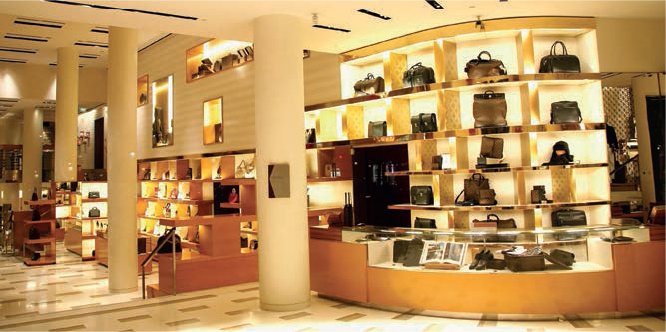
Bags and accessories displayed at Louis Vuitton.

The Chanel eyewear collection for Spring/Summer 2009 is promoted in a window display.
Perfume The fragrance and perfume market is a vital business sector for luxury fashion brands. Fragrance and cosmetics sales at LVMH, for example, accounted for 16 per cent of the group’s revenue in 2007 and 2008. Introducing a fragrance as a strategy for growth is not a new phenomenon. Paul Poiret can lay claim to be the first fashion designer to launch a line of perfumes and cosmetics in 1911; the House of Worth introduced a branded perfume in 1925; and Gabrielle ‘Coco’ Chanel launched the world famous Chanel Nº 5 in 1921. The global fragrance and perfume market is predicted to reach sales of US$ 33 billion by 2012 (Global Industry Analysts, Inc 2008) with the European share of the world market estimated at 46 per cent in 2008.
Lifestyle and homeware This market can provide opportunity for a fashion brand or retailer wishing to develop and diversify its business. Ralph Lauren is a brand famous for its lifestyle and homeware products, and US fashion retailer Anthropologie offers an extensive range of bedding, curtains, cushions, tabletop and linens as well as lifestyle products such as bathroom products, candles and stationery. The Spanish retailer Zara has stand-alone home stores offering a similar range of products.
Other markets – denim and sportswear The global denim market is reputed to be worth about US$50 billion annually and data provided by the NPD Group, Inc indicates that denim accounts for 17 per cent of all apparel purchases, with jeans making up 73 per cent of this figure. Over 800 million denim jeans are bought in the world each year. Fashion industry analysts at Mintel predict that by 2012 the UK jeans market will exceed £2 billion, with the men’s sector forecast to top £1 billion, women’s jeans £846 million and children’s jeans in the region of £136 million.
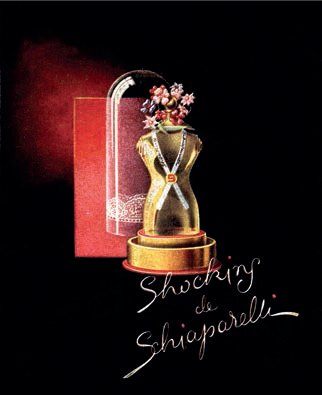
An advert for Shocking, the fragrance launched by Elsa Schiaparelli in 1937. The curvaceous bottle, shaped like a woman’s torso, was modelled on the physique of Mae West and designed by the surrealist artist Léonor Fini.
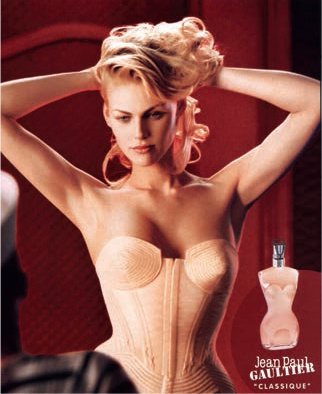
The Jean Paul Gaultier signature fragrance takes its inspiration for the bottle design from the Schiaparelli original.
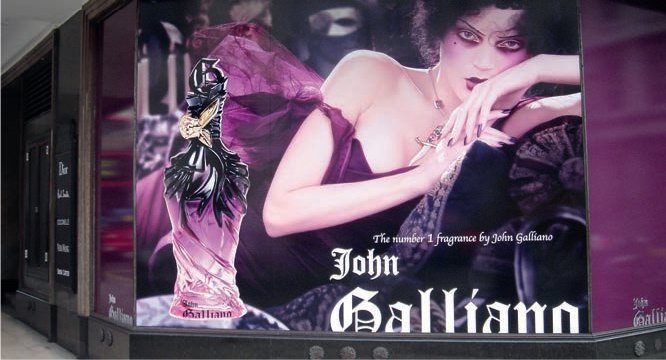
A poster advertises the launch of John Galliano’s first signature fragrance in 2008.
Fashion can be divided into two overarching levels:
•Haute couture and couture
•Ready-to-wear
Haute couture
Haute couture is literally defined as ‘high sewing’ or ‘fine sewing’ and is fashion at its highest level. Haute couture operates at a quality and standard way above that of luxury designer ready-to-wear. Prices are extremely high (an haute couture dress can sell for a six-figure sum) so there is an unwritten rule of limiting sales of any garment of over £100,000 to one per continent to ensure the exclusivity that clients expect. For lesser-priced garments, sales are usually confined to no more than three per continent. Haute couture clients view themselves as art patrons and consider these clothes to be a collectable form of art and an investment. The term ‘haute couture’ is protected by law and governed by very strict rules set by the Chambre Syndicale de la Haute Couture in Paris. To be classified as a bona fide haute couturier a fashion house must create made-to-order garments for private clients. They must also produce two collections a year, employ a minimum of 15 full-time staff, run an atelier in Paris and show a set minimum of runway looks, or ‘exits’, as they are known, of evening and daywear. In the 1980s and 1990s the Italian designer Valentino showed over 180 exits for his haute couture show, now he produces only 40. Very few design houses are approved as haute couture establishments and allowed to show in Paris; Chanel, Dior, Jean Paul Gaultier, Valentino, Giorgio Armani, Jean-Louis Scherrer, Elie Saab, Dominique Sirop, Stéphane Rolland and Franck Sorbier are all recognized as true haute couturiers by the Chambre Syndicale.

Haute couture sits at the pinnacle of fashion. Although only a small sector of the overall market, its influence on designer and high-street fashion is of great importance. Designers distil ideas from their own couture collections and use them in a more commercial format for their ready-to-wear collections. In turn the designer and luxury brand ready-to-wear collections set the trends followed by mass market fashion retailers. When trends work their way down from the top of the market to the bottom, it is known as a trickle-down effect.
Haute couture relies on the expertise of many highly skilled artisans and craftspeople who labour behind the scenes to produce all the luxurious embroideries, trimmings and accessories required by the haute couturiers. Traditionally Paris has been home to a large number of studios or ateliers specializing in millinery, shoemaking, embroidery, beading, creating decorative flowers, buttons and costume jewellery. In 1900, Paris had over 300 plumassiers or feather specialists; today the Lemarié atelier is virtually the only one still in existence. Chanel bought the business along with five other specialist craft ateliers: Michel, specializing in millinery; shoemakers, Massaro; embroidery house, Lesage; button and costume jewellery makers, Desrues; and the gold and silversmith, Goosens. While many argue that something as arcane and extravagant as haute couture cannot or should not survive, it seems that demand has not diminished. Chanel employs around 200 couture specialists, while haute couture sales at Christian Dior couture were worth €765 million in 2008, an increase of 35 per cent on the previous year. However, haute couture is a relatively small business in fashion terms; couture at Dior accounts for only 4 per cent of overall LVMH sales. The real value of haute couture is its power as a marketing tool. Global names such as Chanel, Armani and Dior receive valuable press coverage of their haute couture collections, raising the status and desirability of their brand and keeping it in the public eye.
Fashion designers that are not recognized by the Chambre Syndicale can still produce exclusive custom-made clothing but this must be marketed as couture rather than haute couture. Prices for couture can still be high. The British designer Giles Deacon produces two or three couture pieces a year and a dress may cost more than £40,000. The price of a Vera Wang wedding dress can be in the region of US$25,000, although in an attempt to keep customers happy during the recession, Wang introduced what she calls demi-couture with a lower price tag.
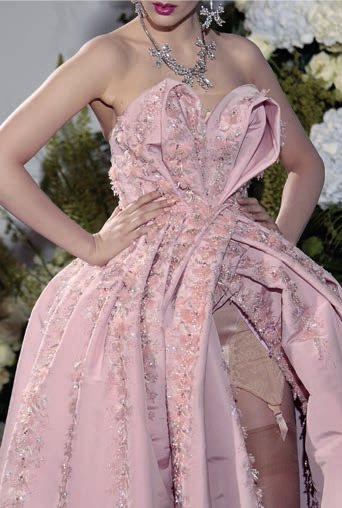
Christian Dior haute couture for Autumn/Winter 2009/10. Gowns created for this exclusive market are sumptuously embellished with hand-worked beading and embroidery.
Ready-to-wear
Fashion product that is not custom-made for an individual client is known as ready-to-wear or off-the-peg clothing. Ready-to-wear garments are premade, come in predetermined sizes and are usually mass-produced and industrially manufactured. Ready-to-wear fashion is available at all levels of the market including:
•High-end fashion
•Middle market
•High street
•Value fashion
Middle market fashion product is designed and priced to cater for customers wishing to purchase at a level between luxury and mass market. A designer or fashion brand that has established itself within the high-end market, may decide to introduce a secondary diffusion line or bridge line, as it is known in the United States, so that they can extend their brand into the middle market. See by Chloe could be classed as a diffusion line, as could Betty Jackson Two, the secondary line to the main Betty Jackson range. High-street retailers such as Banana Republic, Cos, Hoss Intropia, Whistles and Reiss can also be considered as mid-market. The term middle market is not particularly inspiring and is not always perceived by retail brands as a position they wish to aspire to. Some combat this by re-stating their market level, claiming they offer affordable luxury or masstige (prestige for the masses, or mass luxury) rather than mid-market fashion. Affordable luxury and masstige fashion are seen as an important market opportunity now that so many fashion consumers view luxury as something that should be available to all, even those with limited budgets.
Mass market fashion is a term used when referring to high-street multiples or fashion retail chains such as Gap, Topshop, or Zara, available on high streets in most major cities or towns, or internationally, as in the case of Gap or Zara. At this level of the market, terminology can become slightly confusing as ‘high street’, ‘fast fashion’ and ‘mass market’ are descriptions also used in reference to retailers such as Primark, New Look or Kiabi at the lower end of the market.
According to Just-style, the value sector was worth €50bn across Europe in 2008, experiencing growth while the rest of the pan-European fashion market suffered a decline of 5.2 per cent. Value retailers such as Primark, French retailer Kiabi and Germany’s Takko are expanding their chains throughout Europe. Primark already has stores in Spain, Germany and the Netherlands, and Takko in Austria, the Czech Republic, Hungary, the Netherlands, Lithuania and Estonia. Worried by the increasing number of value retailers encroaching on its market, the Spanish fashion chain Mango launched a new low-cost line in August 2009 called ‘Think Up’ in a bid to stay competitive. The new 90-piece range is marketed with the slogan, ‘Low cost ideas for creative living’.
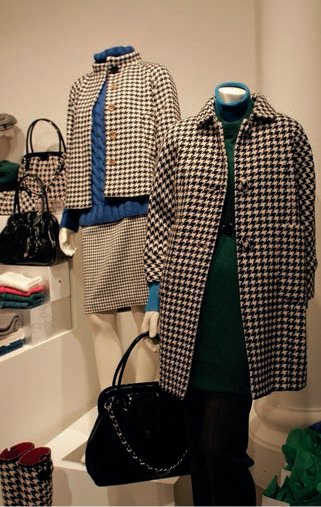
This Banana Republic window illustrates how the mid-market retailer offers fashion with a luxurious feel at affordable prices.
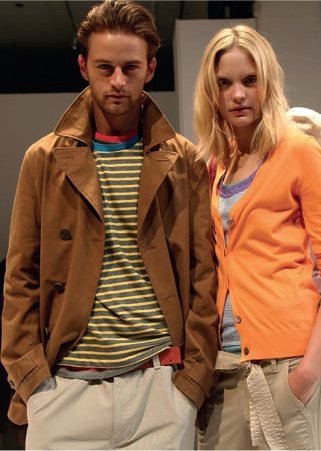
High-street fashion multiple retailer, Gap presents its Spring 2009 collection at Mercedes-Benz Fashion Week in New York.
The demarcation between different levels within the fashion market is becoming ever more complicated and hard to pin down with clarity. An increasing number of fashion companies are implementing strategies to extend their businesses or brands in a bid to appeal to a wider range of customers. As the Mango Think Up example illustrates, a retailer or fashion brand can extend its appeal by introducing more affordably priced product. Alternatively they can reposition upwards by offering luxury and premium products aimed to attract a more discerning customer willing to pay a higher price.
A fashion brand is constructed to make money from merchandise designed for different levels of the market. At the top of the range, the most expensive and luxurious product may be exclusive and available in limited quantity. These couture and ultra-premium ranges may operate as a loss leader but act as a promotional tool to secure the brand’s status. To make money, brand companies must extend their offering to a wider range of customers. An example is the brand architecture of Armani described below.
Armani Privé: couture and ultra-premium, top-of-the-range product with very high price points. Targets customers in the 35–60 age bracket. Armani Collezioni: priced approximately 20 per cent lower than the main line, this collection is aimed at the discerning customer who cannot afford the signature price points. Emporio Armani: targeted at the young professional aged 25–35. Diffusion line providing contemporary Armani designs. Armani Jeans and A/X Armani Exchange: both aimed at a younger age bracket of 18–30. These collections have a more casual and relaxed style; they make the Armani brand accessible to more consumers.
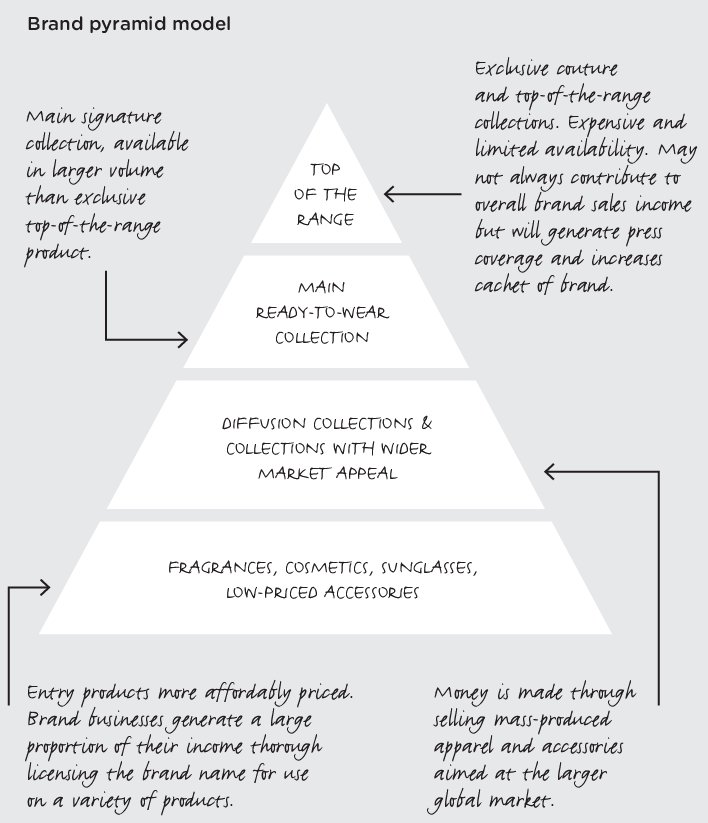
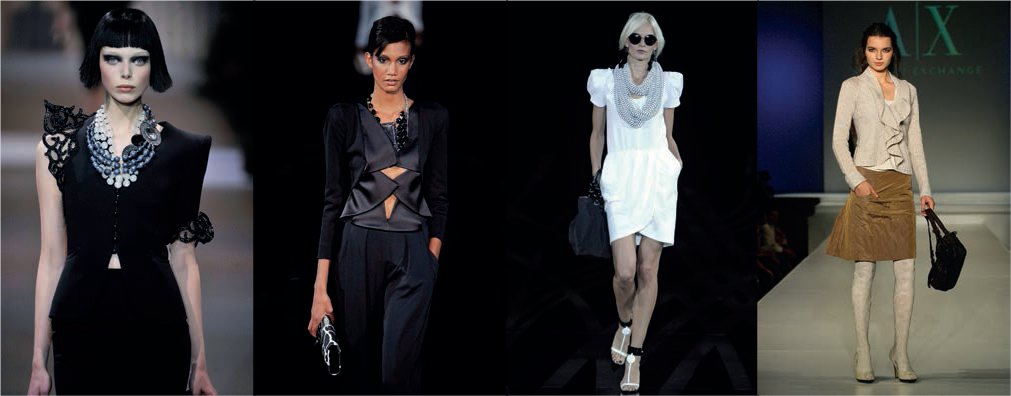
Armani Privé
Armani Collezioni
Emporio Armani
Armani Exchange
Other fashion markets
In addition to the basic fashion sectors described so far, there are other markets, such as vintage fashion and sustainable fashion, that have emerged during the twenty-first century. Vintage or thrift fashion refers to collectable second-hand garments, shoes or accessories from the past sold in specialist vintage or charity shops, or on sites such as eBay. The market has grown in prominence as an increasing number of consumers choose vintage or thrift as a way to make a fashion statement, stand out from the crowd, save money or be more sustainable and consume less.
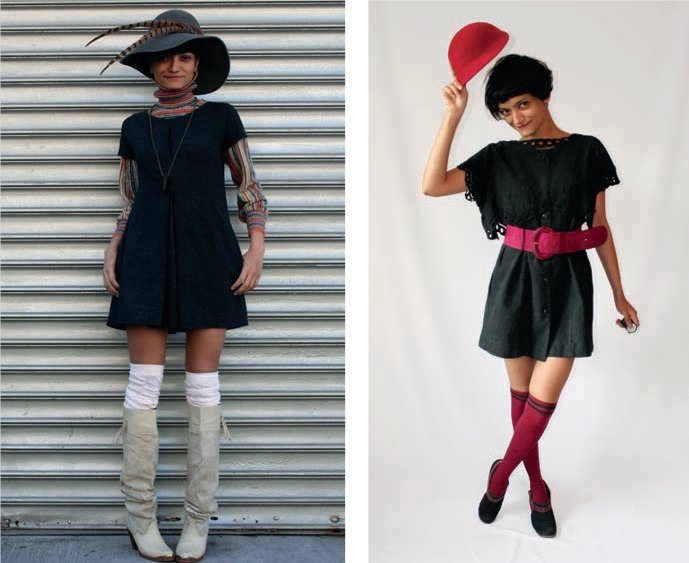
Sheena Matheiken of the Uniform Project wore one of seven identical dresses every day for a year. Each day the dress was styled and accessorized using a variety of vintage and thrift accessories so as to create a fresh new look. In the photograph on the left, the dress is worn with the inverted pleat at front and the buttons at the back. In the right-hand picture the dress is reversed.
One highly innovative initiative utilizing vintage and charity shop fashion accessories was instigated by the Uniform Project Foundation, a non-profit organization advocating a socially responsible future through creative means. The foundation’s mission is to embrace a sustainable culture through design, fashion, social media and business philanthropy. The project was started in May 2009 by Sheena Matheiken, a creative director at an interactive ad agency in New York, and Eliza Starbuck, a design consultant. The idea was to wear one dress for a year as an exercise in sustainable fashion. Eliza designed a basic dress for the project that could be worn front or back, or as an open tunic. The dress was made from durable, breathable cotton, a fabric suitable for both winter and summer. Seven identical versions of the dress were produced so that Sheena had one for every day of the week. Each day, Sheena transformed the dress and fashioned a fresh new look by layering and styling it with a variety of vintage, thrift or hand-made garments and accoutrements. Extra items were sourced from eBay, vintage boutiques, charity shops and flea markets, or donated by friends and bloggers. The project was an ingenious exercise in sustainability and a great way to promote vintage, but there is also a serious side to the Uniform Project, as its main purpose is to raise funds for the Akanksha Foundation, a grassroots movement revolutionizing education of underprivileged children in India.
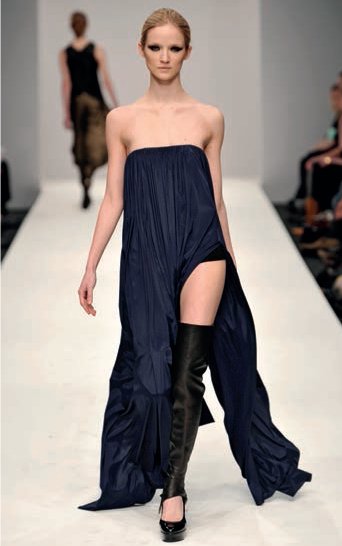
The luxury fashion label, NOIR was founded in Denmark by Peter Ingwersen. The company’s mission is to ensure that international minimum standards on human rights, labour and the environment are adhered to for the sourcing, manufacture and creation of the NOIR, BLLACK NOIR and Illuminati II collections. The guidelines of the UN Global Compact, the International Labour Organization and the International Chamber of Commerce are used in a bid to provide fashion that is created based upon corporate social responsibility principles. Ingwersen’s aim is to prove that high-quality fashion is not incompatible with social responsibility and ethical practice.
Sustainable fashion, also known as ethical fashion or eco-fashion, is another growing sector of the market. An increasing number of fashion companies endeavour to ensure their collections are ethically sourced, or at least some elements of their product offer are produced sustainably. According to the 2009 Mintel report on ethical fashion, sales of sustainable fashion in the UK quadrupled over the five years leading up to 2008, increasing by £40 million to £175 million.
Issues of sustainability and ethics affect every aspect of the fashion supply chain, from production of raw materials, clothing manufacture, distribution and marketing through to retail. Determining what is or is not sustainable is extremely complicated, not helped by the fact that sustainable fashion is used as an umbrella term to describe a range of practices that include:
•Use of certified organic fibres such as cotton or linen
•Use of renewable fibres such as bamboo and maize
•Recycling of fibres and garments
•Use of natural dyes or low-impact dyes
•Breaking the cycle of consumption by creating a long-lasting product
•Fair-trade raw materials and fibres
•Ethical labour and ethical farming practices
•Reduction in energy consumption
•Minimal or reduced packaging
It is claimed that the fashion industry is 10–15 years behind the food industry in terms of public understanding and with so many issues to get to grips with, many consumers find the topic confusing. The biggest problem is establishing what can or cannot be termed eco, sustainable or ethical fashion. A growing number of designers, fashion retailers and industry bodies are working together to clarify the issues, set clear standards, introduce regulation and clear labelling and raise the profile of sustainable fashion. Opportunities to sell and promote wholesale collections are improving, with London Fashion Week and Prêt à Porter Paris® both now incorporating sustainable fashion within their remit with estethica in London and So Ethic in Paris.
Fashion cities and trade fairs
Paris, London, Milan and New York have traditionally been the most influential centres of fashion; each of the fashion capitals has its own specific characteristics derived from its history and the development of particular artisanal or manufacturing skills.
Paris
Paris is the spiritual home of fashion and the epicentre of haute couture. The haute couture shows take place each year; Spring/Summer collections are shown in January, and Autumn/Winter in July. Men’s ready-to-wear works on a different timescale: shows in January feature collections for the following Autumn/Winter; June is the showcase for the next Spring/Summer. There are only about 30 menswear shows so this is a much smaller event than Paris Fashion Week, which hosts approximately 100 womenswear ready-to-wear shows; Autumn/Winter in March and Spring/Summer at the end of September/ early October. Paris Fashion Week is extremely important and many designers from all over the world choose Paris to show their seasonal ready-to-wear collections, knowing that the fashion press and buyers from the most prestigious boutiques and department stores will flock to the city to view the runway shows. Rick Owens, from the United States, Ann Demeulemeester and Dries Van Noten from Belgium, Viktor & Rolf from Amsterdam, Vivienne Westwood, John Galliano and Stella McCartney from the UK, Costume National from Italy and Zucca, Comme des Garçons and Junko Shimada from Japan are just some of the foreign designers showing in Paris.
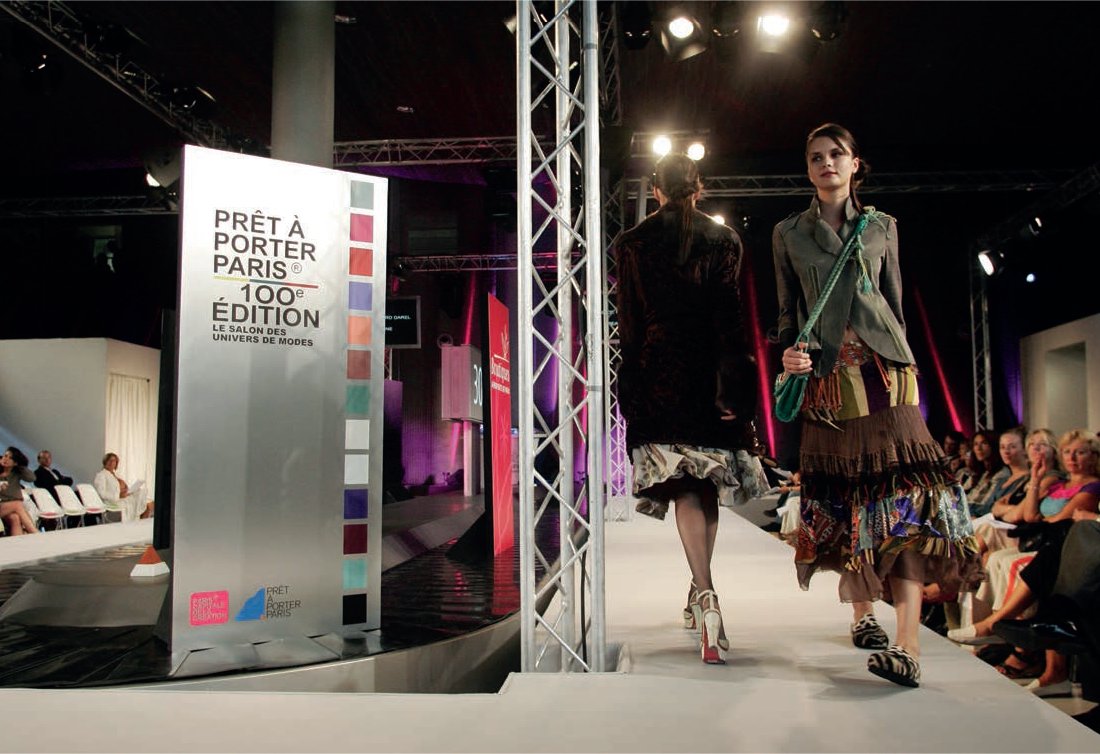
Prêt à Porter Paris® is a leading international fashion trade fair and recognized brand name associated with several key fashion industry trade events in Paris, New York and Tokyo.
As well as Paris Fashion Week, there is also Prêt à Porter Paris® at the Porte de Versailles, a trade show where over a thousand exhibitors from a variety of different fashion markets exhibit their product. Prêt à Porter Paris® is an international brand with several sub-branded shows: Atmosphère’s in Paris; The Box, an accessory fair that takes place in both Paris and New York; The Train, a fashion and accessory trade fair held in the Terminal Warehouse building in New York’s Chelsea district; and Living Room, held in Tokyo for womenswear, menswear, fashion accessories and lifestyle products. Première Vision, or PV, held twice a year – in February for the following Spring/Summer season and September for the next Autumn/Winter – is the largest European textile trade show and a major date in the calendar for international designers and buyers. The fair is an important trade opportunity for textile suppliers from all over the world but it is also used by fashion designers and buyers for its focus on colour and trend prediction.
London
Ever since the Swinging Sixties and Mary Quant, London has been famous for its street style and avant-garde fashion and this remains one of the city’s biggest claims to fashion fame. Today, it is designers themselves who are London’s greatest fashion export. John Galliano, Alexander McQueen and Stella McCartney have all gone on to work in fashion houses in Paris, and many other hard-working British or London-trained designers have found employment in New York, Milan, Hong Kong, China, India and Japan. London is a magnet for fashion students from around the globe. After graduation some stay on, start their own labels and make London their base.
London Fashion Week has become a major event on the fashion circuit with designers like Vivienne Westwood, Paul Smith, Betty Jackson, Nicole Farhi, Erdem, Luella Bartley, Alice Temperley and Matthew Williamson. London’s reputation was given a major boost when Burberry returned to show its Spring/Summer 2010 collection on the catwalk at London Fashion Week in 2009. For wholesale brands there are trade shows such as Pure London, which gives a platform to over 800 brands; Betty Jackson, who presents her main collection at London Fashion Week, shows her diffusion label Betty Jackson Two at Pure. Although not traditional fashion trade fairs, the Spring and Autumn fairs at the NEC in Birmingham and Top Drawer and Pulse in London showcase companies selling gifts and fashion accessories, such as bags, scarves, hats or jewellery.
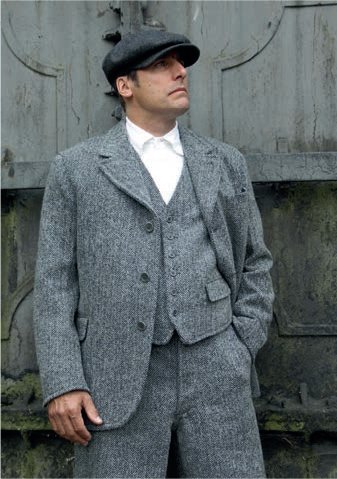
Grey herringbone suit in Harris Tweed by British Company, Old Town. The company uses British fabrics for all of their men’s and women’s clothing. Historically the UK was a centre of textile production. Harris Tweed is a trademarked fabric made famous by Vivienne Westwood, who used the worn, renowned fabric for her collections in 1987/88, and Nike, which used the fabric to make a special-edition trainer in 2004. Scotland still has a strong reputation for other wool fabrics and knitwear made from lambswool and fine cashmere.
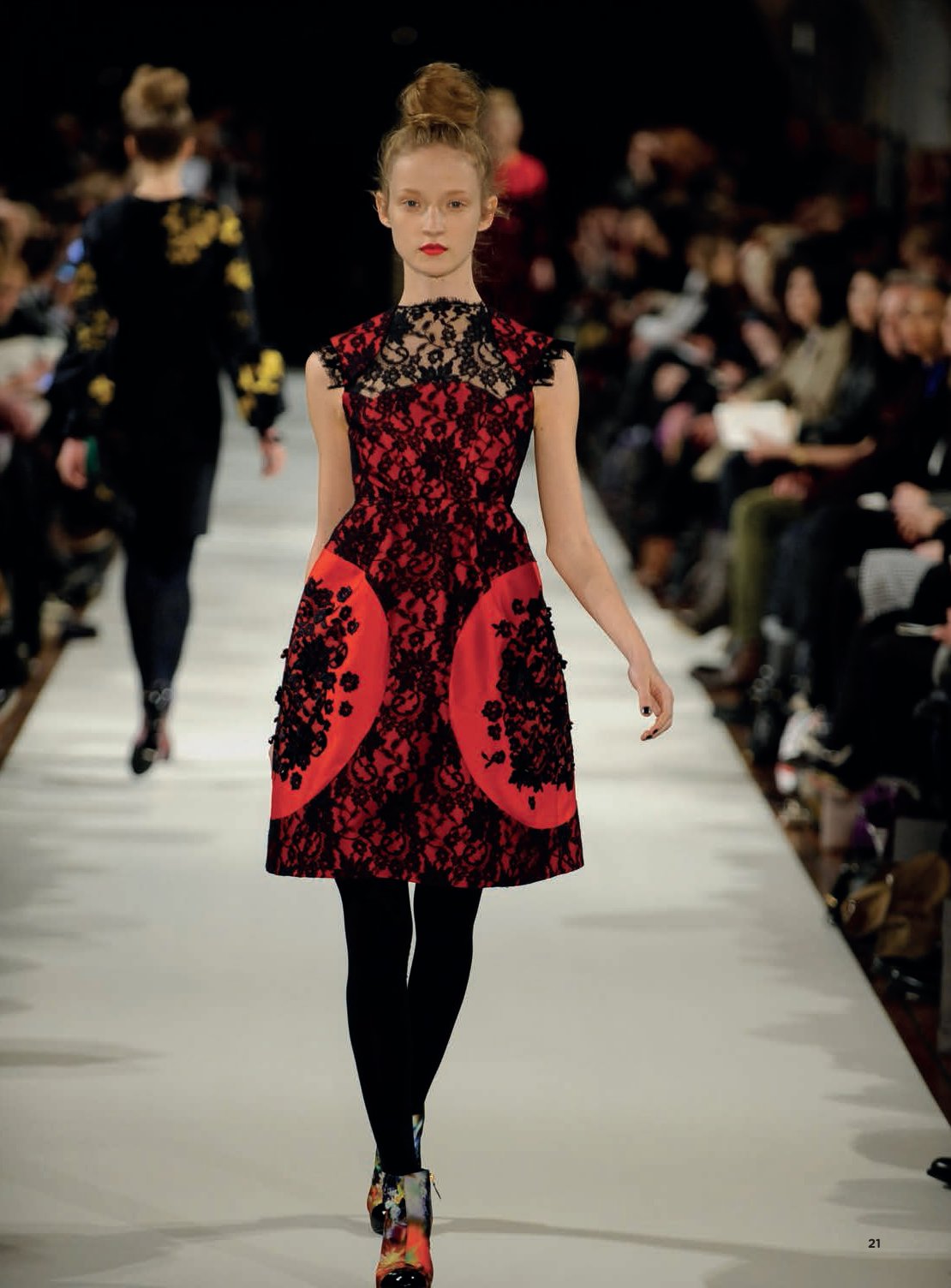
Red and black lace dress, Erdem Autumn/Winter 2009/10. The Canadian designer Erdem Moralioglu showcases his eponymous fashion label on the catwalk at London Fashion Week.
The London Edge trade fair caters for the alternative clubwear market. Within this market there are several niche categories such as gothic, punk, cyber, techno, glam rock, heavy metal, rockabilly, industrial, underground, festival ethnic and biker. London Central trade fair focuses on urban streetwear, showcasing brands covering the skate, hip hop, surf and hippy end of the youth market.
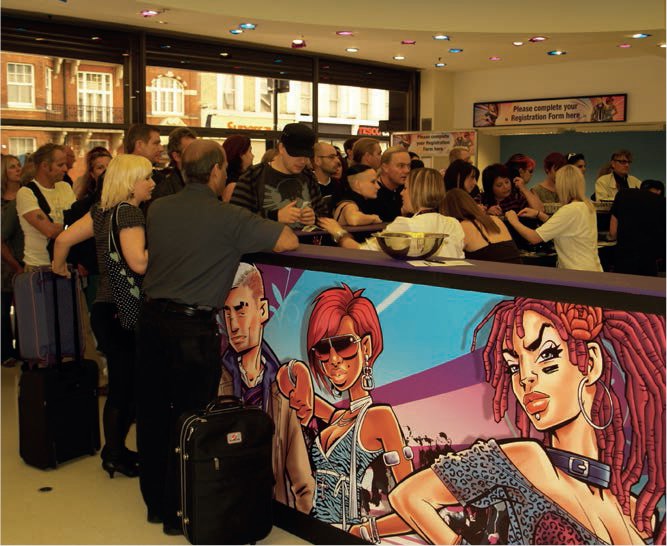

Milan
Italian couture, or alta moda, can be traced back to 1951 when the Marquis Gian Battista Giorgini held the first haute couture fashion show in Florence for a select few designers and clients. Rome took over as the centre for high fashion in Italy during the 1960s but lost ground during the 1970s and 1980s to Milan, which became the commercial capital for Italian ready-to-wear. Today, Italy is an important country for the design and manufacture of luxury and mid-market fashion, with particular expertise in leather goods, footwear, knitwear and high-quality ready-to-wear for both men and women. Milan is a major trade centre where most of the design houses have their headquarters and where the majority of Italian fashion shows take place. It is also an important location for Italian fashion magazine publication, so satellite industries such as styling, photography and modelling also gravitate to the city. Italy is well known for its textile industry; Florence and Prato are important centres for the manufacture of yarn and knitwear, Como produces silk fabrics and the Piedmont area manufactures wool textiles. Key industry trade fairs and catwalk shows are held in Milan, Florence and Rome. Milan hosts Milano Moda Donna for women’s ready-to-wear and Milano Moda Uomo for menswear. AltaRomaAltaModa in Rome shows Italian couture and high-level ready-to-wear and Florence is the location for the Pitti Filati knitwear and yarn fair, Pitti Uomo menswear and Pitti Bimbo childrenswear trade fair.
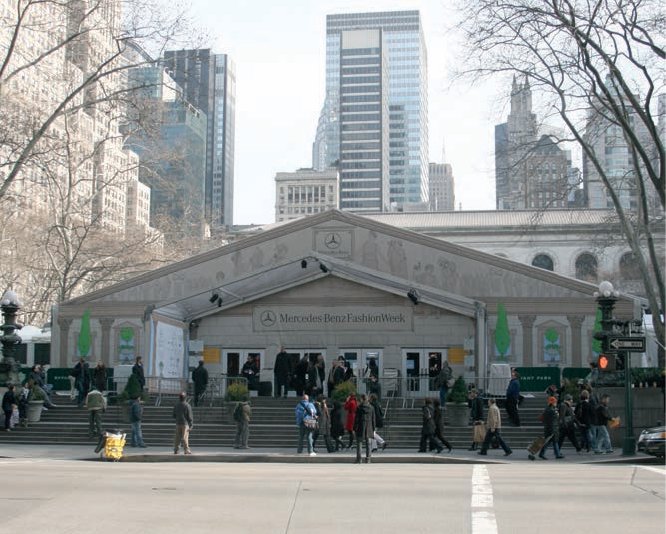
The tent at Mercedes-Benz Fashion Week, New York.
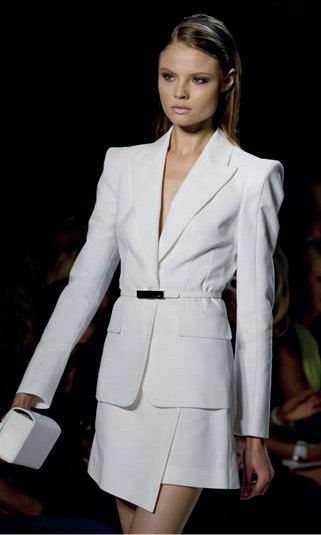
Michael Kors runway show for Spring/Summer 2010 shown at Mercedes-Benz Fashion Week
New York
New York is the heart of the US fashion and apparel industry and some of the world’s most recognizable brands, like Ralph Lauren, Tommy Hilfiger, Kenneth Cole and Liz Claiborne, have their offices and design studios in the city. American fashion is renowned for its relaxed, fluid, casual and chic style, epitomized by designers like Lauren as well as Michael Kors, Donna Karan and Calvin Klein. Retailers like Nike, Gap, Banana Republic and Esprit also have strong global appeal for their accessible and desirable fashion.
Historically, apparel and textile manufacturing was one of the United States’ largest sectors. It has suffered a decline due to competition from manufacturing counties like China, but the industry still employed over half a million workers in 2007.
Mercedes-Benz Fashion Week (formerly Olympus Fashion Week) attracts 100,000 trade and press visitors and generates US$466 million in visitor spending each year, according to the New York City Economic Development Corporation. Calvin Klein, 3.1 Phillip Lim, Anna Sui, BCBGMaxazria, Carolina Herrera, Davidelfin, Diane von Furstenburg, Donna Karan, Isaac Mizrahi, Michael Kors, Zac Posen and Narciso Rodriguez are just some of the names that show at this prestigious event.
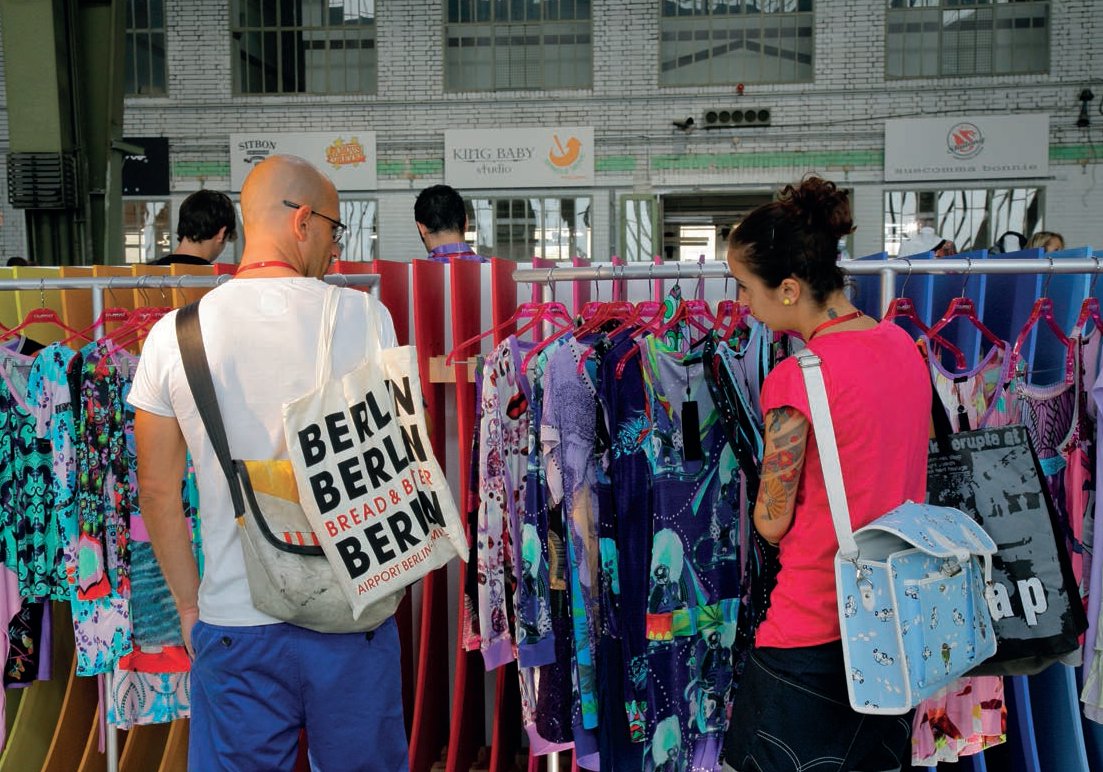
Other fashion cities and trade fairs
India, Sri Lanka, Australia, Hong Kong and China and Japan all hold their own fashion week events to showcase designers and promote their region’s fashion industry. In the US, Los Angeles plays a vital role in promoting fashion on the West Coast. The city is gaining a reputation for fashion design with acclaimed labels Rodarte and Band of Outsiders based there. In 2009, Rodarte, designed by sisters Kate and Laura Mulleavy, won the Council of Fashion Designers of America’s (CFDA) Womenswear Designer of the Year award and Scott Sternberg’s Band of Outsiders won the award for CFDA Menswear Designer of the Year. LA also holds two major international textiles and sourcing fairs, GlobalTex and L.A. Textile. Portland, Oregon is an important centre for fashion and active sportswear companies. Nike, Adidas, Columbia Sportswear, Jantzen swimwear and Keen footwear all have headquarters there as do eco-fashion brands such as Nau, Entermodal and A Fortes Design.
In Europe, Berlin hosts Bread & Butter, an international specialist trade fair for streetwear, denim and sportswear brands. Düsseldorf holds the CPD womenswear and accessories fair, and HMD (Herrenmode Düsseldorf) for menswear. Spain is well known for the manufacture of footwear and leather goods; the country holds two international footwear and leather trade fairs – Modacalzado + Iberpiel in Madrid and Futurmoda in Alicante.
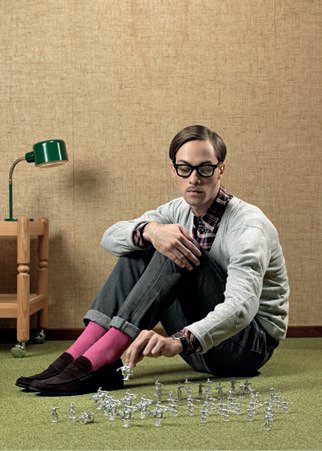
Sweden is gaining a reputation for cutting-edge and directional denim brands. One denim label making a name for itself is Dr Denim, started in 2003 by the Graah family in Göteborg. Their Autumn/Winter 2010 collection was exhibited at, Terminal 2 in Copenhagen, Bread & Butter in Berlin and Modefabriek in Amsterdam.
